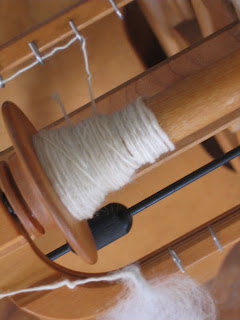 Waffle weave fascinates me. So last summer I decided to do a set of hand towels in waffle weave for my bathroom. My bathroom needed some color, so I picked several colors from my stash of 8/2, made up a pattern that looked fun on WeaveDesign, and calculated how many warps of each color I would need.
Waffle weave fascinates me. So last summer I decided to do a set of hand towels in waffle weave for my bathroom. My bathroom needed some color, so I picked several colors from my stash of 8/2, made up a pattern that looked fun on WeaveDesign, and calculated how many warps of each color I would need. When I calculated the length for a set of four towels, it was so close to the whole spool for some of the colors, I decided to use all of it and make six towels. That meant a 12 yard warp, not the longest I've done-- but I wasn't taking some circumstances into account that would make this the most challenging warping up I've done (so far).
Because I was using several warp colors, I decided to warp front to back, and spent the afternoon feeding the warp ends into the reed and the heddles, then tying then in neat little bundles onto the warp beam rod.
June is normally pretty mild. But this summer was the wettest, most humid summer Vermont has ever had. That day began somewhat humid, but it wasn't too bad when I began this project. But as the day went on, it became warmer and more humid. As I began warping the loom, the temperature had hit the high 90s and the humidity was in the 90s too. Though feeling the effects, I didn't think about how the warp might be affected.
So far, things had gone reasonably well: I had had only two crosses on the loom, easily fixed, and was ready to wind on. I set up my jugs, using extra to accommodate the smaller multi-colored bundles, tied on the warp bundles and prepared to wind them on.
What I didn't realize yet was that as the afternoon cooled into the 80s, the humidity approached, then exceeded 100%. I was too busy to look out and see the mist coalescing in the late afternoon air.
Bad mistake. Retrospect is such a wonderful thing. I should have stopped there, and chained my warp and waited until a drier day (as the next day proved to be).
But, oblivious me, I kept going. As the cotton absorbed the moisture from the air, the strands swelled and began twining on itself and onto each othe, even across bundles! Normally, these fibres are a dream to warp, sliding past each other easily. Not that evening. The moisture created friction, so that the fibres wouldn't slide past each other Worse: each color behaved a little differently. I had clumps of warp twined around each other despite the tension they were under, and refusing to budge. No, I did NOT take any photos of this part!
Maddenly frustrated and genetically stubborn, I stuck to it, winding on a few inches at a time, separating more warp, winding that on. As I realized what I'd gotten myself into, I wanted to give up and go to bed, but didn't dare, fearing what JellyBean (who loves string) might do during the night. So I kept going, finally got the jugs to the loom around midnight, and left them. (I figured the tension was high enough that JB couldn't do any damage.)
This should have taken 15-20 minutes max from the point I tied on the jugs. It took me six hours. Midnight, and I was exhausted. I learned my lesson: do not warp in high humidity. Next time, I'm waiting.
Okay, now to the fun part. Next day the weather was much drier, and finishing the warp was a breeze (if only I'd waited... all those hours of frustraton!) All I have to do now is weave. Because I used so many colors in the warp, I decided to just use natural to weave. Here we go:
 |
| Waffle weave on the loom-- very first towel |
 |
| remember you can click on photos to enlarge! |
 |
| Stack of finished towels, one showing the two textured sides |
 |
| ...and green edges! |










































